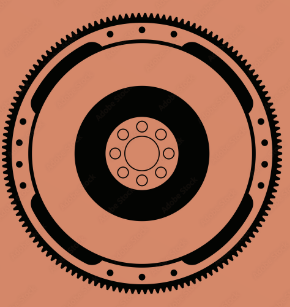- Home/
- GATE MECHANICAL/
- GATE ME/
- Article
Flywheel – Function, Working Principle, Types, Uses
By BYJU'S Exam Prep
Updated on: September 25th, 2023

The Flywheel is one of the most important devices in the list of engineering Mechanical devices. The flywheel was invented 1000 years ago (between the years 1038 – 1075) by Neolithic spindles and potter’s the wheel. So, what is a flywheel? What is the purpose of inventing the flywheel? Let us discuss this in this article.
It is a very simple device that we can see in many machines. This article gives a basic idea about the flywheel, requirements, and functions of the flywheel, the working principle of a flywheel, the force acting on the flywheel, type, and the application of the flywheel.
Table of content
What is a Flywheel?
Generally, a flywheel is the perfectly rigid circular element that is mounted on the crankshaft of the engine, or a rotating shaft subjected to transfer the power. The flywheel’s function is to control the fluctuation in the rotating element. The flywheel has a high mass moment of inertia, due to this, it has the ability to absorb and release a high amount of energy whenever required.
Many machines have load patterns that cause the torque time function to vary over the cycle. So, to overcome this type of condition the flywheel is the best solution. As Cast iron is cheap, mostly cast iron is used for the manufacturing of the flywheel. For longer life steel can also be used, as it has properties of high strength and anticorrosion, making it durable.
Flywheel Diagram
Function of Flywheel
In general, flywheel functions are to provide smooth power output in case of the fluctuating mode of an energy resource (for example IC engine, Steam engine) or to provide a sufficiently large amount of energy in a short period of time. Based on this the main functions of the flywheel are as follows:
- To minimize the jerk in the machine element
- To store the excessive amount of rotational kinetic energy when the machine is in idling or no-load condition
- To supply a large amount of energy in the minimum time.
- Balancing the rotating element mounted on the same haft but in a different plane
Working Principle of Flywheel
The main working principle of the flywheel is based on the Rotational mass moment of inertia, Where the rotational kinetic energy is stored and released in the wheel, when the wheel store kinetic energy the rotational speed of the wheel gets increases. When the demand for high energy is required, the Wheel releases its kinetic energy and the wheel’s speed gets slower.
The Kinetic energy stored on the flywheel depends on the mass moment of inertia and the speed of the flywheel. The energy stored in the flywheel is given by the equation
Kinetic Energy= (1/2)I ω2
Where,
- I – Mass moment of inertia
ω– Mean angular speed of the wheel
As speed changes kinetic energy associated with the flywheel also changes, the change in the kinetic energy of the flywheel is given
Change in Kinetic Energy = Kinetic energy at initial−Kinetic energy at final
Change in Kinetic Energy = (1/2)I ωi2– (1/2)I ωf2
ΔK.E.=(1/2)I ω2[(𝜔i−𝜔f)/𝜔]
Where
- 𝜔i– The initial angular speed of the wheel,
- 𝜔f– Final angular speed of the wheel
Types of Flywheel
As per our requirement, availability of space and design point of view flywheel can be classified into the following type:
- Rim type flywheel – Used for low Speed
Moment of inertial for Rim type flywheel is given by: I= (MR2)/2 - Rim and Spook type flywheel – For medium speed
- Disc type flywheel – For high speed
Moment of inertial for Rim type flywheel is given by: I = MR2
Flywheel Uses
The main uses of the flywheel are as follows:
- IC Engine, Steam engine – In this case flywheel stores a fluctuating form of energy and supply smooth and less fluctuating power in the output
- Diesel generator
- Punching and blanking operation – In this case, a smooth input energy source is there, but with the help of a flywheel, we generate a high amount of energy in less time.
- Gyroscope – Applying a flywheel in a gyroscope is to maintain stability and control the direction, where friction is not dominant. For example – the satellite direction is controlled by using the flywheel in the gyroscope



